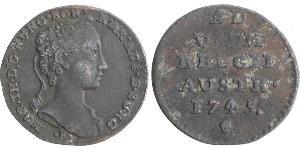10 Dollar USA (1776 - ) Gold
Metal:
State:
Issue year(s):
1795-1797
TURBAN HEAD TEN DOLLARS OR EAGLE – SMALL EAGLE REVERSE
Small Eagle – Capped Bust Facing Right (1795-1797)
Designer – Engraver: Robert Scot
Metal Composition: 92% Gold – 8% Silver and Copper
Diameter: 33 mm
Mass / Weight: 17.5 grams
Early ten dollar gold pieces were given the name ‘eagle,’ at the time the Coinage Act of 1792 was enacted. Until 1849, Eagles were the largest gold coins produced by the first U.S. Mint; the first series is from 1795 through 1797 and displays a small eagle reverse. Like all early gold coins, these pieces did not carry a denomination as part of the design. John Dannreuther explains: ‘The eagle was the second gold denomination struck by the United States Mint. Calling it a denomination is actually a misnomer. Even though a gold eagle was denominated as a ten-dollar coin, our forefathers traded gold by the tale. [Tale, in this instance, means count or tally, a number of things taken together (i.e., the weight and purity of an individual coin).] The weight and purity were the only things important to merchants and individuals -- money was gold, and gold was money. In most cases, transactions of even a nominal sum had to be settled in gold, especially whenever governments were involved. There really was no need at first for a stated denomination on either gold or silver coins, because it was known that our coins would be under extreme scrutiny and would likely be assayed by foreign mints and others as to their weight and purity.’ (At the time, British gold coins also did not carry a standard denomination.) “In his new reference, Early U.S. Gold Coin Varieties, Dannreuther provides estimated mintages for every variety, as well as estimates of the number of survivors for each variety. What is known for sure is that the number of die marriages known from 1795 through 1804 (32) and the total mintage for that period (132,714 coins including 122 pieces reserved for assay). By using the midpoint of Dannreuther's survival estimates, we can also establish an approximate survival rate for the series of 2.5%.” Many of the Mint State 1795 Eagles have Prooflike tendencies, much like this coin does. Although the fields are not deeply mirrored, they are clearly reflective. The surfaces are excellent and almost totally mark-free with only a few scattered abrasions as noted. Faint adjustment marks are evident at the center of the reverse, and also on some of the reverse denticles. All of the design features on both sides are boldly made as though given an extra strong blow from the dies.
11
coins in the group
| 1 | 2 |
|---|
(1205 X 600 pixels, file size: ~159K)
Posted by: anonymous 2015-03-05
1797. Small Eagle. BD-1. NGC graded MS-63. In NGC holder 1562003-001. Mostly well struck on a remarkably clean planchet and shimmering with luster. Medium golden-yellow with some faint hairlines seen only under magnification. Only 55-65 known in all grades. With the exception of the 1795 9 lea ...
(1205 X 600 pixels, file size: ~154K)
Posted by: anonymous 2015-03-05
1795 $10 Capped Bust. 13 leaves. . BD-5, Taraszka-5, Breen-6830. NGC graded MS-64. Rarity 5. Set in NGC holder with certification number 1951316-002. Well struck and intensely lustrous with semi-reflective frosty mint surfaces throughout. Date is widely spaced on this variety (one of four 13 l ...
(1205 X 600 pixels, file size: ~167K)
Posted by: anonymous 2015-03-05
1795. 13 leaves below eagle. . BD-1, Rarity 3+. NGC graded AU Details, obverse planchet flaw. A rather pleasing looking coin with mint caused minor planchet flaws in the left obverse field and some scattered minor marks about the rims here and there. Plenty of detail and all, overlaid with nat ...
(1205 X 600 pixels, file size: ~167K)
Posted by: anonymous 2015-03-02
1795. 13 leaves below eagle. . BD-1, Rarity 3+. NGC graded AU Details, obverse planchet flaw. A rather pleasing looking coin with mint caused minor planchet flaws in the left obverse field and some scattered minor marks about the rims here and there. Plenty of detail and all, overlaid with nat ...
(1205 X 600 pixels, file size: ~167K)
Posted by: anonymous 2015-03-02
1795. 13 leaves below eagle. . BD-1, Rarity 3+. NGC graded AU Details, obverse planchet flaw. A rather pleasing looking coin with mint caused minor planchet flaws in the left obverse field and some scattered minor marks about the rims here and there. Plenty of detail and all, overlaid with nat ...
(1005 X 500 pixels, file size: ~150K)
Posted by: anonymous 2015-03-01
1795. BD-4, Breen-6830, Taraszka-4. NGC graded MS-64. A trifle soft in the center and some light adjustment marks across the eagle's breast feathers. The lustrous surfaces are quite reflective. Dies identifiable by 5 in date being free from bust, and a leaf distant from U(NITED) on the reverse ...
YouTube
You may be interested in following coins
2025-05-25
- New coin is added to 1 Liard Austrian Netherlands (1713-1795) Copper
1 Liard Austrian Netherlands (1713-1795) Copper
group has 4 coins / 4 prices
⇑
Austrian Netherlands. Maria-Theresa (1740-1780). Ae Liard, 1745 Angel head Brussels (Ae - 3,34g - 22mm). KM 1. About very fine.
2025-06-16
- Historical Coin Prices
You may be interested in ...

-500-250-MOzBwcI0VMoAAAEorhwTYXKA.jpg)
-300-150-X4EKbzbi1AsAAAFLRpX6Agt0.jpg)
-300-150-R7MKbzbinhIAAAFLM4L6Agt0.jpg)
-300-150-vqUKbzbiffEAAAFLMjj6Age6.jpg)
-300-150-g_YKbzbiOI0AAAFLvWOjltvV.jpg)
-300-150-jKMKbzbi_Q8AAAFLhk2jltgE.jpg)
-300-150-Lc8KbzbirN0AAAFLdkCjltQP.jpg)






-300-150-P8gsHgTy6VEAAAGTRmDWdZPt.jpg)







